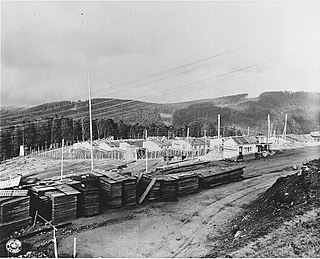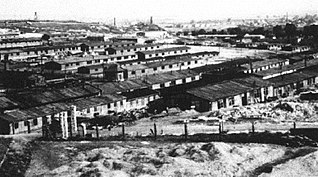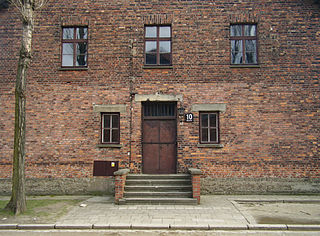
Auschwitz concentration camp was a complex of over 40 concentration and extermination camps operated by Nazi Germany in occupied Poland during World War II and the Holocaust. It consisted of Auschwitz I, the main camp (Stammlager) in Oświęcim; Auschwitz II-Birkenau, a concentration and extermination camp with gas chambers; Auschwitz III-Monowitz, a labour camp for the chemical conglomerate IG Farben; and dozens of subcamps. The camps became a major site of the Nazis' Final Solution to the Jewish question.

Nazi Germany used six extermination camps, also called death camps, or killing centers, in Central Europe during World War II to systematically murder over 2.7 million people – mostly Jews – in the Holocaust. The victims of death camps were primarily murdered by gassing, either in permanent installations constructed for this specific purpose, or by means of gas vans. The six extermination camps were Chełmno, Belzec, Sobibor, Treblinka, Majdanek and Auschwitz-Birkenau. Extermination through labour was also used at the Auschwitz and Majdanek death camps. Millions were also murdered in concentration camps, in the Aktion T4, or directly on site.

Natzweiler-Struthof was a Nazi concentration camp located in the Vosges Mountains close to the villages of Natzweiler and Struthof in the Gau Baden-Alsace of Germany, on territory annexed from France on a de facto basis in 1940. It operated from 21 May 1941 to September 1944, and was the only concentration camp established by the Germans in the territory of pre-war France. The camp was located in a heavily-forested and isolated area at an elevation of 800 metres (2,600 ft).

Stutthof was a Nazi concentration camp established by Nazi Germany in a secluded, marshy, and wooded area near the village of Stutthof 34 km (21 mi) east of the city of Danzig (Gdańsk) in the territory of the German-annexed Free City of Danzig. The camp was set up around existing structures after the invasion of Poland in World War II and initially used for the imprisonment of Polish leaders and intelligentsia. The actual barracks were built the following year by prisoners. Most of the infrastructure of the concentration camp was either destroyed or dismantled shortly after the war. In 1962, the former concentration camp with its remaining structures, was turned into a memorial museum.

Płaszów or Kraków-Płaszów was a Nazi concentration camp operated by the SS in Płaszów, a southern suburb of Kraków, in the General Governorate of German-occupied Poland. Most of the prisoners were Polish Jews who were targeted for destruction by Nazi Germany during the Holocaust. Many prisoners died because of executions, forced labor, and the poor conditions in the camp. The camp was evacuated in January 1945, before the Red Army's liberation of the area on 20 January.

Rudolf Hermann Brandt was a German SS officer from 1933–45 and a civil servant. A lawyer by profession, Brandt was the Personal Administrative Officer to Reichsführer-SS Heinrich Himmler and a defendant at the Doctors' Trial at Nuremberg for his part in securing the 86 victims of the Jewish skull collection, an attempt to create an anthropological display of plaster body casts and skeletal remains of Jews. He was convicted of war crimes and crimes against humanity and executed in 1948. Felix Kersten, a Finnish doctor who reportedly saved thousands of Jews by influencing Himmler during the massage therapy he gave him throughout the war, tried to save Brandt from execution, as Brandt helped him by adding names on the lists intended to save camp prisoners.

Josef Kramer was a Hauptsturmführer and the Commandant of Auschwitz-Birkenau and of the Bergen-Belsen concentration camp. Dubbed The Beast of Belsen by camp inmates, he was a German Nazi war criminal, directly responsible for the deaths of thousands of people. He was detained by the British Army after the Second World War, convicted of war crimes, and hanged on the gallows in the prison at Hamelin by British executioner Albert Pierrepoint.

August Hirt was an anatomist with Swiss and German nationality who served as a chairman at the Reich University in Strasbourg during World War II. He performed experiments with mustard gas on inmates at the Natzweiler-Struthof concentration camp and played a leading role in the murders of 86 people at Natzweiler-Struthof for the Jewish skull collection. The skeletons of his victims were meant to become specimens at the Institute of anatomy in Strasbourg, but completion of the project was stopped by the progress of the war. He was an SS-Hauptsturmführer (captain) and in 1944, an SS-Sturmbannführer (major).

Wolfram Sievers was a Nazi and convicted war criminal for medical atrocities carried out while he was managing director (Reichsgeschäftsführer) of the Ahnenerbe from 1935–1945. He was convicted of war crimes in the Doctors' Trial in 1947 and executed by hanging in 1948.

Bruno Beger was a German racial anthropologist, ethnologist, and explorer who worked for the Ahnenerbe. In that role he participated in Ernst Schäfer's 1938–39 journey to Tibet, helped the Race and Settlement Office, or SS-Rasse- und Siedlungshauptamt, of the SS identify Jews, and later helped select human subjects to be killed to create an anatomical study collection of Jewish skulls.

Vaivara was the largest of the 22 concentration and labor camps established in occupied Estonia by the Nazi regime during World War II. Some 20,000 Jewish prisoners passed through its gates, mostly from the Vilna and Kovno Ghettos, but also from Latvia, Poland, Hungary and the Theresienstadt concentration camp. Vaivara was one of the last camps established. It existed from August 1943 to February 1944.
During the 20th century there were various alleged instances of soap being made from human body fat. During World War I the British press claimed that the Germans operated a corpse factory in which they made glycerine and soap from the bodies of their own soldiers. Both during and after World War II, widely circulated rumors claimed that soap was being mass-produced from the bodies of the victims of Nazi concentration camps which were located in German-occupied Poland. During the Nuremberg trials items were presented as evidence of such production. The Yad Vashem Memorial has stated that the Nazis did not produce soap with fat which was extracted from Jewish corpses on an industrial scale, saying that the Nazis may have frightened camp inmates by deliberately circulating rumors in which they claimed that they were able to extract fat from human corpses, turn it into soap, mass-produce and distribute it.
The Freundeskreis der Wirtschaft, or Circle of Friends of the Economy was a group of German industrialists whose aim was to strengthen the ties between the Nazi Party and business and industry. The group was formed and co-ordinated by Wilhelm Keppler, one of Adolf Hitler's close economic advisors.

Block 10 was a barrack at the Auschwitz concentration camp where men and women were used as experimental subjects for Nazi doctors. The experiments in Block 10 ranged from testing bodily reactions to relatively benign substances and sterilization.

Numerous internment camps and concentration camps were located in France before, during and after World War II. Beside the camps created during World War I to intern German, Austrian and Ottoman civilian prisoners, the Third Republic (1871–1940) opened various internment camps for the Spanish refugees fleeing the Spanish Civil War (1936–1939). Following the prohibition of the French Communist Party (PCF) by the government of Édouard Daladier, they were used to detain communist political prisoners. The Third Republic also interned German anti-Nazis.

The Reichsuniversität Straßburg was founded in 1941 by the Nazis in Alsace after the annexation of Alsace-Lorraine by Nazi Germany. The University of Strasbourg had moved to Clermont-Ferrand in 1939. The university's purpose was to restore the German character of the Kaiser-Wilhelm-Universität, as the University of Strasbourg was named from 1872 to 1918, and to advance "German knowledge" in the annexed territory. When the Allies arrived in Alsace in 1944, the Reichsuniversität was first transferred to Tübingen and then dissolved.
Hans Fleischhacker was a German anthropologist with the Ahnenerbe and a commander in the SS of Nazi Germany. He worked with Bruno Beger on some projects, making measurements of Jewish people. He was with Beger at Auschwitz when the people were selected to be part of the Jewish skull collection, a project of the Ahnenerbe. At their post-war trial, Beger was found guilty of full knowledge of the scope of that project, while Fleischhacker was found not to be aware that the purpose of the measurements was to select the 86 people to be murdered at Natzweiler-Struthof camp.
Franz Hermann Johann Maria Freiherr von Bodmann, sometimes written as Bodman was a German SS-Obersturmführer who served as a camp physician in several Nazi concentration camps.

Hans-Joachim Lang is a German journalist, historian, and adjunct professor of cultural anthropology at the Ludwig-Uhland Institute for Empirical Cultural Studies University of Tübingen. Dr. Lang researched and authored the award-winning book Die Namen der Nummern, published in 2004, which identified all of the victims murdered in the gas chamber of the Natzweiler-Struthof concentration camp for Nazi anatomist August Hirt as part of his plan to create a pseudo-scientific Jewish skeleton collection during World War II.
Alice Simon was a German woman of Polish and Jewish ancestry, who was killed by the Nazis during The Holocaust. Her remains were later identified as part of the Jewish skull collection, and she is commemorated with a Stolperstein in front of her former home in Berlin.


















